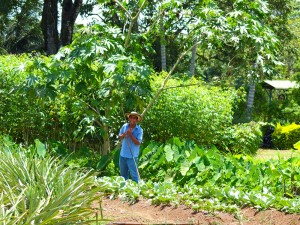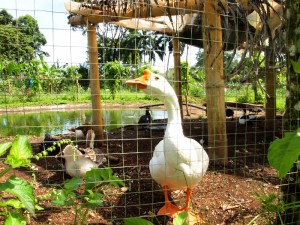A perfect circle: Mandala gardening
A stone splashes into the water creating graceful circles that expand outward. Heiner Castillo, academic administrator and manager of EARTH’s Integrated Organic Farm, is demonstrating how Mandala gardening is based on the natural world’s own patterns.
“Mandala,” he says, is Sanskrit for “sacred circle of energy” or “vital energy of the universe.” Although the name gives the garden an element of mysticism, the practice is also based on science. The philosophy is simple: if energy is the driving force behind change and creation, then, we should do our best to channel the energy around us to “create an environment of better harmony,” says Heiner.
Going with the flow
How can we apply the Mandela principle to gardening? Heiner explains that a circular design “allows the energy around the garden to flow the way it naturally flows – in a circular form.” Indeed, he points out that large energy masses on our planet are often expressed in circular patterns, citing tornados, ocean whirlpools and hurricanes.
The Mandala garden at EARTH’s organic farm has nine rings of crops encircling a pond. In this aspect, the design is intended to mirror previous conceptions of a nine-planet solar system. In the suns place the pond serves as the energy center. It provides a key source of irrigation, allowing farmers to save money and energy they would otherwise spend on water distribution systems. The pond is also home to tilapia fish and ducks, providing consistent sources of protein.
Nourishing families and communities
The crop rings have three purposes: nourishment for the family, food for the community (to barter with others or bring to market) and protection against wind-driven soil erosion.
In fact, Mandala gardening began in Brazil, with the idea of strengthening rural communities’ economic resilience and food security in the face of droughts. An EARTH student who had interned with The Mandala Agency in Brazil brought the idea back to the University. It has flourished since. Indeed, Heiner says it has become “an important tool for us.”
“It really brings together fundamental concepts that we work on with EARTH students – not only organic ones, but also institutional ones,” he reflects. “It’s a strategy to increase soil efficiency, and it also has a strong philosophical concept. So, it helps us to teach the students that behind everything we do, there is always a reason. It’s not just about agriculture; it’s a good strategy for fostering food security and community development, too – all in a little garden. And it’s beautiful to look at.”
What’s the idea behind it? First, families learn about nutrition and then plant crops to create a complete meal. The crops should provide nourishment and ideally, be tasty, too. In EARTH’s garden, the first three inner rings are producing sweet potato, cassava, beans, pineapple and chili pepper – all part of the Caribbean province’s traditional diet. Families can complement such produce with protein from the pond: duck eggs or meat and fish.
In the next three outer rings, families plant crops to bring to market or to exchange with neighbors. In this way, community connections can be fostered and strengthened.

In EARTH’s garden, the first three inner rings are producing sweet potato, cassava, beans, pineapple and chili pepper while in the next three outer rings, families plant crops to bring to market or to exchange with neighbors.
Cultural relevance and respect for ancestral traditions
Cultivating a Mandala garden is about more than producing food. “We respect our grandparents’ ancestral knowledge, too,” Heiner shares, pointing to the ginger plants. For generations, local families have made ginger tea to cure colds. Thus, including such crops in the garden shows respect for cultural heritage in an important way.
The MasterCard Foundation Scholar Liliana Armero Guerrero (‘15, Colombia) relates the Mandala garden to her own background, too. On a pad of paper, she draws a spiral, what she calls a “cosmic swirl.” The symbol is traditional to the indigenous peoples of southern Colombia, including her home community. Liliana appreciates how, with the Mandala garden, farmers can draw energy not only from the earth, but also from the sky.
“Here, it’s about looking for new models,” she comments, “through which you can learn that there’s something different from monoculture, it is worth it, and that you can get good results. It’s more viable on a family level, and it’s also helpful economically.” She looks forward to working with the garden more during her Work Experience module at the Integrated Organic Farm in the coming weeks.
“Making art with agriculture”
Liliana is not the only student with whom the Mandala garden has resonated. David Molina (‘15, Costa Rica) has also enthusiastically shared the practice with others. As a member of the student Agro-ecological Club, he has collaborated with other students on establishing a Mandala garden behind the student dorms. He has also helped communities install their own Mandala gardens around the country, including the Mujeres Mandala (Mandala Women, in English) group, in the Cartago province.
David embraces Mandala gardening for many reasons. He loves the way that the aquatic and agricultural systems within it complement each other; a toad near the pond, he says, can both fertilize the garden and eat disease-carrying insects. He also appreciates Mandala gardens’ potential as a source of joy for people.
David shares, “It’s a tourist attraction that can be used in ecological or sustainable agriculture projects, that also has a beauty to it.” He encourages people to play with the colors and aesthetic of the garden, too. “Something that the Mandala has done for me and many fellow rural farmers,” he says, “is that we are doing art through agriculture; people are having fun.” With its sometimes-meditative quality, the creative activity can help people relax and rejuvenate, as well.
He sees something else powerful about Mandala gardening, too: it can attract young people to farming. So many go to the cities for work, but already, he knows friends who are creating Mandala gardens in urban spaces, too.
Ultimately, David says, he sees Mandala gardening as “a return to the origins of humanity’s connection with the fields and the earth” – with so many new possibilities






Excelente el Sist. Mandalla
interesante!!! hay que tener la mente abierta!!, felicidades
Mis felicitaciones por lo que hacen… saludos desde ECUADOR